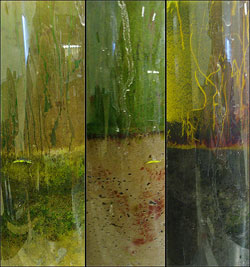Create a Bacterial Ecosystem: Winogradsky Column
(Courtesy of Tom Hanson, University of Delaware)
In this activity, students mix mud, water, a carbon source, and a sulfur source together in a clear bottle. The mud and water contain many different types of bacteria, while the carbon and sulfur serve as "food" for bacteria to grow. After the bottles are left in the sun for several weeks, distinct layers of bacterial colonies in become visible. Each colony fills a specific niche within the bottle ecosystem, generally following each bacteria type's adaptations to the various gradients that form in the column. For example, oxygen is higher at the top of the bottle and decreases to levels of anoxia, while sulfur is greater towards the bottom and decreases upwards in the bottle. A diversity of metabolic strategies can be observed in the Winogradsky column, making this an excellent activity for demonstrating the concept of ecological niche as well as phototrophy, chemotroph, autotrophy, and heterotrophy.
Objectives
- Students will describe various bacteria communities
- Students will understand how different bacteria function in different ways
- Students will predict and test how environmental changes alter bacterial community composition
Materials
- Calcium sulfate (Gypsum or plaster of paris, craft or garden stores)
- Calcium carbonate (garden lime or crushed limestone, garden stores)
- Clean, clear plastic bottle with cap
- Paper towels, finely shredded
- Purchase a Winogradsky column kit from Carolina Biological Supply
- Water
- Mud or soil
- Windowsill or lamp
- Winogradsky Column Instructions
Procedure
- Mix 2 parts paper towels to 1 part calcium sulfate and 1 part calcium carbonate in the bottom of the bottle.
- Add mud to fill the bottle about 25% of the way up and enough water to mix all the components.
- Add more mud on top of the bottom layer until the bottle is ~75 % full (see diagrams in Winogradsky Column Instructions sheet).
- Fill the bottle with water to just below the neck and loosely cap.
- Place the bottle in a window that receives sunlight or by a lamp. If using a lamp, make sure that the bottle is not so close that it gets hot.
- Growth should develop in 2-4 weeks and continue to change over 6-8 weeks before becoming stable. Add water if necessary and the column should remain stable. See Winogradsky Column Instructions or the listed web links for explanations of specific types of bacterial colonies (and their metabolic strategies) that are cultured in the column.
Questions for Students
- List your observations.
- Draw a picture of your column, noting observations about any layers that may have formed.
- Describe the different colors of microbe communities in your bottles. Can you make inferences about how the different types of microbes obtain energy?
- Add the following to your drawing: oxygen gradient; sulfur gradient. In other words, where is oxygen highest/lowest and where is sulfur highest/lowest? How do you know? (This question may be more appropriate for older students. )
Optional Experiments
- What does each of the additions provide for the column (Paper towels, CaSO4, CaCO3)?
- Does light quality (color) affect the types of bacteria grown from a single mud? Why? Use colored cellophane wrapped around duplicate columns made from the same mud.
- Does adding a fertilizer change what types of bacteria grow from a single mud? Duplicate columns, one with a small amount of garden fertilizer, one without.
- Is light necessary? Make a duplicate column wrapped with foil and see if anything develops.
- Does the same mud always give the same types of bacteria? Do different muds and soils produce different bacteria? Are certain types of muds “richer” in bacteria than others? Make multiple columns from one mud sample and make single columns from multiple mud samples.
- What can be done further with each population?
Lesson Resources
![]() Winogradsky Column Instructions
Winogradsky Column Instructions
Animated Winogradsky Column Tutorial
Winogradsky Lesson: The "General Biology of the Column" section gives a great in-depth explanation of what each type of bacteria does (probably too advanced for students but will help teachers understand these processes in depth).
Winogradsky Website from the University of Delaware
National Science Education Standards
K-12 Unifying Concepts and Processes
- Evolution and equilibrium
9-12 A Science as Inquiry
- Abilities necessary to do scientific inquiry
9-12 B Physical Science
- Chemical reactions
9-12 C Life Science
- The cell
- Biological evolution
- Interdependence of organisms
- Matter, energy, and organization in living systems
- Behavior of organisms